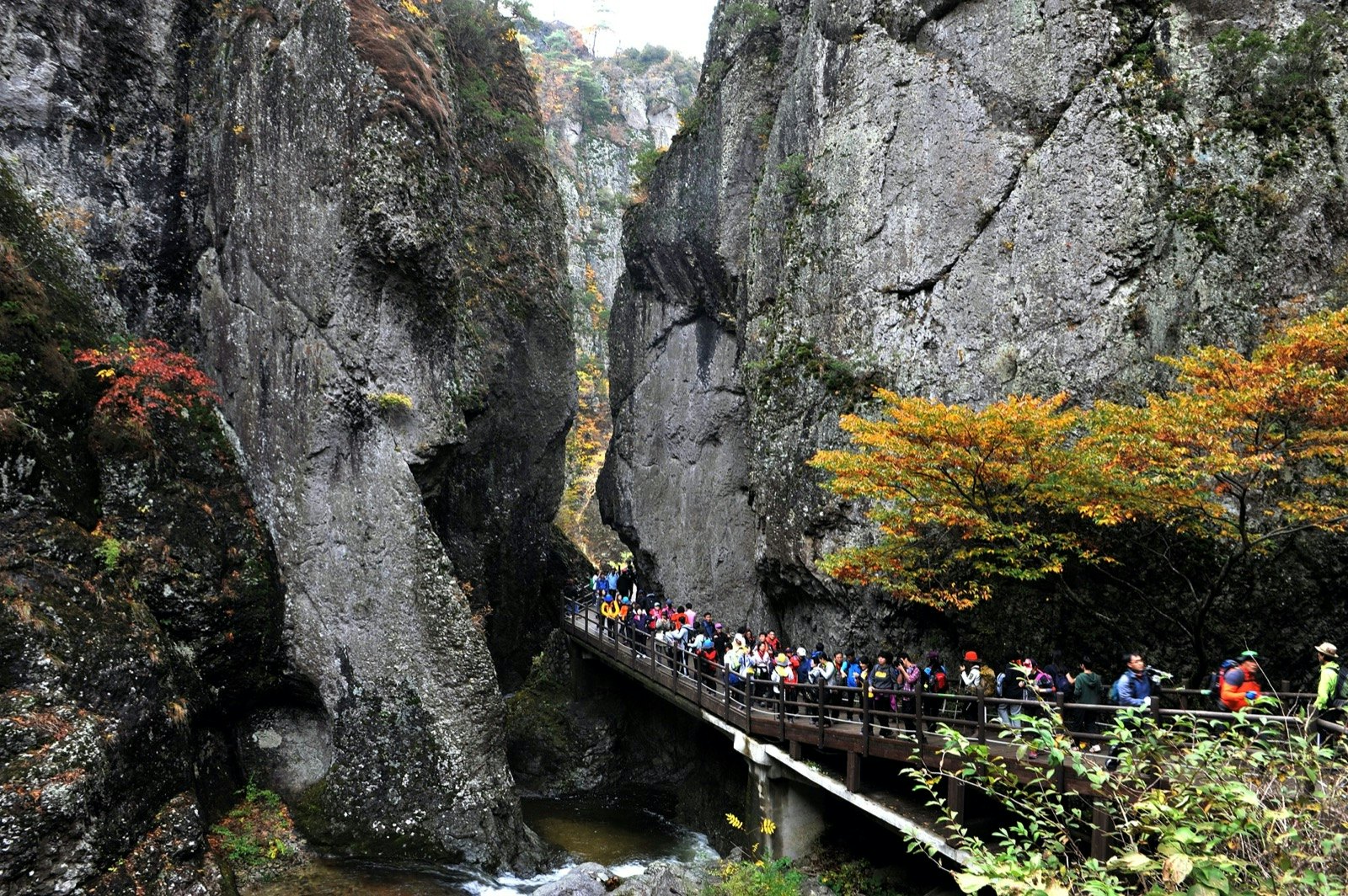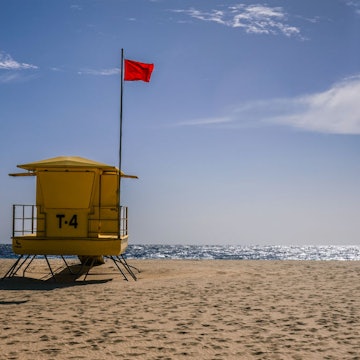
Exploring the natural treasures of South Korea’s Gyeongbuk region
Oct 19, 2020 • 7 min read

The Gyeongbuk region of South Korea features spectacular scenery and countless ways to enjoy nature © Gyeongsangbuk-Do Culture and Tourism Organization
South Korea offers a wide range of experiences to suit every traveler. Travelers will fall in love with the rich culture of the Korean people as well as an exquisite culinary scene, bustling night markets, and of course, K-Pop music. South Korea also offers exhilarating outdoor adventures from camping, hiking, and even skiing. A few hours southeast of Seoul is where you will find the spectacular scenery and fresh air of Gyeongbuk, and countless options to enjoy the surrounding nature.
What will strike travelers is the sheer beauty of the majestic mountain ranges, exotic rock formations, crystal clear lakes, and dramatic waterfalls. Formally known as Gyeongsangbuk-do, Gyeongbuk preserved these natural gifts and developed national parks to assure that they can be enjoyed by generations to come. Today these national treasures offer plenty of ways to breathe in the fresh air while exploring walking trails, exhilarating hikes, or even overnight camping.

Cheongsong and Yeongyang are ideal locations for a two- or three-day outdoor adventure in South Korea. Although the region is known for its production of Korean ‘Sundown’ apples and fiery hot Korean chili pepper, the area is mountainous making it difficult to cultivate. As a result, the population is sparse and 80 percent of the territory is undeveloped, so the region is filled with unspoiled nature and an ideal setting for outdoor adventures.
Because of the area’s good roads, sloping hills, and stunning scenery, it also makes an ideal location for exhilarating bicycling adventures. There are a number of well-laid-out routes that take riders through the countryside, national parks, and around lakes as well as quaint villages. Plenty of bicycle rental shops are in the area so no need to worry if you did not bring your bike along. Most will consider the terrain to be moderate and not overtaxing however many bike shops have electric bikes on rental as well should you wish to minimize your exertion.

Juwangsan National Park
Located in Cheongsong, Juwangsan is a UNESCO Global Geopark with towering mountains, limestone pinnacles, waterfalls, and lakes, and gorgeous panoramic views. Photographers will argue that the autumn is the most beautiful season, as the leaves change to a kaleidoscope of colors across the picturesque valley.
In addition to the stunning natural vistas, there are several temples inside the park worthy of a visit as well. The most popular is the Daejeonsa, which was originally built in 672 (A.D.) by the Great Monk Uisang and houses multiple national treasures.

The 106-sq-km Juwangsan National Park is known for its three waterfalls and verdant valleys as well as the narrow gorges, steep cliffs, caves, and unusual limestone rock formations. There are several routes as well as an easy 45-minute trek without any steep hills, so you will often see families and the elderly on the trail.
The Jugwansan Mountain is 720 meters tall and is part of Baekdudaegan (the Baekdusan Mountain range) which forms the backbone of the Korean peninsula. For those seeking something a bit more demanding, they can choose to scale the steeper trails up the mountainside for a bird’s eye view over the park. There are various circuits where athletic hikers can ascend to the ridge overlooking the valley as well as other trails through the main valley’s woodlands and along a stream.

Over thousands of years, the erosion and water flows have created another geological phenomenon and landmark known as the Baekseoktan Stream Pothole. Baekseoktan or “Stream of Shiny White Stone” is exactly what you will see with large white boulders strewn along the riverbed near the mouth of the waterfall.

Jusanji Pond
Also located in Juwangsan National Park is one of South Korea’s most beautiful natural treasures, the Jusanji Pond. The pond is really more the size of a lake and known for its still surfaces that create a mirror-like reflection of the scenic mountain. Jusanji Pond is actually a 300-year-old man-made reservoir that was constructed in 1721. The two-kilometer trail is not demanding and takes about 30 minutes to walk, take in the views, and enjoy the natural vistas around the park.

The lake was made famous when it appeared in the popular Korean film Spring, Summer, Fall, Winter, and Spring and has drawn throngs of visitors ever since. The lake is serene and untouched and, in the center, is an eerie sight; centuries-old willow trees, gnarly and twisted by the seasons, rise above the surface almost like an arm reaching out from the depths. Early mornings are the best time to take in the sights, as the fog blankets the valley and the lake creating a picturesque yet otherworldly sight.

Eoreumgol Valley
Another unusual natural phenomenon is found nearby – as bizarre as this may sound, when the rest of South Korea is experiencing tropical and balmy heat, there is a valley that has freezing temperatures in the summer and, equally as incredulous, only begins to melt when the temperature is zero degrees Celsius.

Aptly named Eoreumgol, or ‘Ice Valley’, the UNESCO Global Geopark is considered one of South Korea’s great mysteries. It is speculated that a flow of frigid air emerges from the underground beginning in March that lasts through most of the summer with temperatures just above freezing at 0.2 degrees Celsius. The valley offers several ways to experience this freak of nature from hikes around the park or perhaps climbing the ice-covered sheer walls. In fact, athletes from around the world descend upon the Ice Valley once a year to for UIAA Ice Climbing World Cup.

Deokcheon Hanok Village
Cheongsong has been recognized as an International Slow-City by the Cittaslow International Organization. Influenced by the slow food movement, the organization identifies cities where the natural environment and traditions of the people are preserved and where development is done in harmony with nature.

Songso House
To look back in time, visit the nearby Songso House, a Hanok is traditional Korean house, home of an Sim’s family built around 1880. The Songso House offers overnight stays as well as a restaurant serving traditional family-style meals. The surrounding areas are quiet and peaceful with Hanok tea house to visit as well.
The region is rich in culture and heritage making it a good destination to explore beyond its glorious natural attributes. To explore this region’s fascinating culinary history, join a cooking class that uses the ancient recipes found in Eumsik Dimibang, the 340-year-old cookbook written by Jang Gyehayng (Poet, Scientist, 1598-1680), a woman of the royal family during Joseon dynasty. The book details how to store, prepare, and ferment dishes served to the 17th century royal families. Workshops are offered by JangGyehayng Center.

Firefly Eco Park observatory
Yeongyang area is one of the best places on earth to see the stars, literally. Because of the region’s mountainous landscape and lack of development, the area has a low density of light pollution making it a habitat ideal for fireflies and as a result, the firefly conservation area was developed to protect the habitat of millions of glowing fireflies.
The glitzy light that we see in major cities may be exciting to see but also creates a form of pollution called ‘skyglow.’ About 30 years ago, the International Dark-Sky Association set out to identify and preserve areas with low light pollution. In these areas, it is much easier to see the 15,000 stars in the sky versus what you see in heavily populated areas.
In addition to a preserved firefly sanctuary, the 1000-acre Firefly Eco Park observatory in Yeongyang is one of only 37 designated International Dark Sky Parks in the world and was the first in Asia. The park is the ideal way to spend an evening stargazing into the clear darkest night at a sea of stars in the Milky Way as blazing meteors shoot across the sky. To experience the bioluminescent from the fireflies and the surreal astrology is nothing less than a treasure from nature.

Yeongyang Subi Starlight Camping
Another wonderful overnight option would be camping under the stars. The Yeongyang Subi Starlight Camping is nestled between the forest and mountains in front of a gurgling stream. The sublime natural setting to explore the stream and forest in the middle of this picturesque valley. The camp’s facilities include a shower and washroom, refrigerators as well as sinks and washing machines. Visitors can arrange their camping gear through several online camping rental shops that deliver to the site. At night, instead of Netflix and cell phones, replace that with sitting around the campfire and gazing at the clear skies above.
South Korea offers a wide range of experiences for the well-heeled traveler. A few hours southeast of Seoul is Gyeongbuk, a destination full of natural gems from parks and lakes to explore during the day and a blanket of stars to sleep under at night.
Author: Glenn Harris















